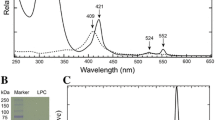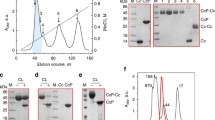Abstract
Cytochromec' ofThiocapsa roseopersicina was partially purified by DEAE and Sephadex chromatography (highest purity index A 275 nm ox./A 396 nm ox.=0.54). It is autoxidizable, thermostable, and is located in the soluble fraction. The reduced cytochromec' reacts with carbon monoxide and has a γ-band at 417 nm and a shoulder at 435 nm. Cyanide (10−2−10−3 M) does not inhibit the reduction of the cytochromec' by sulfide; only at higher concentrations of cyanide did the shoulder at 435 nm disappear. When the cytochromec' is reduced by dithionite, only one broad α-band at about 550 nm appears next to the γ-band. When is is reduced by sulfide, the absorption spectrum shows an additional β-band at 521 nm. Cytochromec' is not reduced by thiosulfate.
Similar content being viewed by others
Literature Cited
Bartsch, R. G. 1971. Cytochromes: Bacterial, pp. 344–363. In: Collowick, S. P., Kaplan, N. O. (eds), Methods in enzymology, vol. 23, New York: Academic Press.
Bartsch, R. G. 1978. Cytochromes, pp. 249–279. In: Clayton, R. K., Sistrom, W. R. (eds.), The photosynthetic bacteria. New York, London: Plenum Press.
Dickerson, R. E., Timkovich, R. 1975. Cytochromes c, pp. 397–547. In: Boyer, P. D. (ed.), The enzymes, vol. 11, New York, San Francisco, London: Academic Press.
Fischer, U., Amrhein, N. 1974. Cyclic nucleotide phosphodiesterase ofChlamydomonas reinhardtii. Biochimica et Biophysica Acta314:412–420.
Fischer, U., Trüper, H. G. 1977. Cytochrome c-550 ofThiocapsa reseopersicina: Properties and reduction by sulfide. FEMS Microbiology Letters1:87–90.
Hatchikian, E. C., Le Gall, J., Bruschi, M., Dubourdieu, M. 1972. Regulation of the reduction of sulfite and thiosulfate by ferredoxin, flavodoxin and cytochrome cc'3 in extracts of the sulfate reducerDesulfovibrio gigas. Biochimica et Biophysica Acta258:701–708.
Higgins, I. J., Knowles, C. J., Tonge, G. M. 1975. Enzymic mechanisms of methane and methanol oxidation in relation to electron transport systems in methylotrophs: Purification and properties of methane oxygenase, pp. 389–402. In: Schlegel, H. G., Gottschalk, G., Pfenning, N. (eds.), Microbial production and utilization of gases: Proceedings of the Symposium on Microbial production and Utilization of Gases (H2, CH4, CO). Göttingen: Akademie der Wissenschaften zu Göttingen.
Kusai, A., Yamanaka, T. 1973. The oxidation mechanisms of thiosulphate and sulphide inChlorobium thiosulfatophilum Roles of cytochrome c-551 and cytochrome c-553. Biochimica et Biophysica Acta325:304–414.
Kusai, A., Yamanaka, T. 1973. Cytochrome c (553,Chlorobium thiosulfatophilum) is a sulphide-cytochrome c reductase. FEBS Letters34:235–237.
Large, P. J., Meiberg, J. B. M., Harder, W. 1979. Cytochrome cCO is not a primary electron acceptor for the amine dehydrogenase ofHyphomicrobium X. FEMS Microbiology Letterss5:281–286.
Lowry, O. H., Rosebrough, N. J., Farr, A. L., Randall, R. J. 1951. Protein measurement with the Folin phenol reagent. Journal of Biological Chemistry193:265–275.
Meyer, T. E., Kennel S. J., Tedro, S. M., Kamen, M. D. 1973. Iron protein content ofThiocapsa pfennigii, a purple sulfur bacterium of atypical chlorophyll composition. Biochimica et Biophysica Acta292:634–643.
Petushkova, Y. P., Ivanovskii, R. N. 1976. Respiration of the cells ofThiocapsa roseopersicina. Mikrobiologiya45:9–14.
Pfennig, N., 1966. Anreicherungskulturen für rote und grüne Schwefelbakterien, pp. 179–189 and 503-504. In: Schlegel, H. G., Kröger, E. (eds.). Anreicherungskulturen und Mutantenauslese, Stuttgart: Gustav Fischer Verlag.
Pfennig, N., Lippert, K. D. 1966. Über das Vitamin B12-Bedürfnis phototropher Schwefelbakterien. Archiv für Mikrobiologie55:245–256.
Strekas, T. C., Spiro, T. G. 1974. Resonace-raman evidence for anomalous heme structures in cytochrome c' fromRhodopseudomonas palustris. Biochimica et Biophysica Acta351:237–245.
Trüper, H. G., Rogers, L. H. 1971. Purification and properties of adenylylsulfate reductase from the phototrophic sulfur bacteriumThiocapsa roseopersicina. Journal of Bacteriology108:1112–1121.
Yamanaka, T., Kusai, A. 1976. The function and some molecular features of cytochrome c-553 derived fromChlorobium thiosulfatophilum pp. 292–301. In: Singer, T. P. (ed.), Flavins and flavoproteins. Amsterdam: Elsevier.
Author information
Authors and Affiliations
Rights and permissions
About this article
Cite this article
Fischer, U., Trüper, H.G. Some properties of cytochromec' and other hemoproteins ofThiocapsa roseopersicina . Current Microbiology 3, 41–44 (1979). https://doi.org/10.1007/BF02603132
Issue Date:
DOI: https://doi.org/10.1007/BF02603132




